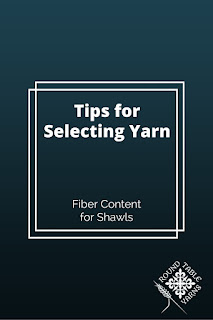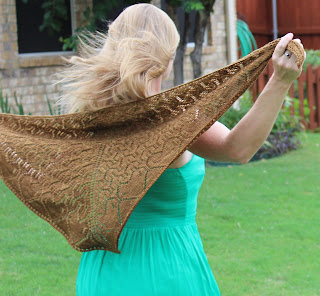In the past, I've just known that I have a preference for natural fibers
(particularly wool) but I hadn't really gone too in depth into
differentiating fiber content. I've been learning more about fiber
content and behavior lately and have even gone further into breaking
"wool" down into more specific breeds. So one of my goals over the next
few years is to get various breeds and knit lots of swatches and small
projects to see how different breeds behave. But that's not what I'm
going to go into here. Instead, let's look at a broader overview and
what kind of yarn you might pick for shawl knitting.
A lot of shawls are written for fingering weight yarn, and I'm sure
you've heard people say that if you have a bunch of sock yarn in your
stash, you can make shawls instead of yet another pair of socks. And
although that is true in most cases, take a closer look at your "sock
yarn." Sometimes people use "sock yarn" and "fingering weight"
interchangeably but sometimes "sock yarn" is a bit more specific. Think
about the properties of yarn that you might want for your socks:
something that is going to hold up to wear especially around the heel
and toes. So what gets put in a lot of yarns intended for socks? Nylon.
And nylon is a great strengthener for making socks. But it's not always
that great when you want to make shawls. Do you really need your shawl
to stand up to a lot of heavy wear? (If the answer is yes, then perhaps
nylon in the yarn would be a good idea for you.) Also, most yarns that
are intended for socks will have a tighter twist (again, so it will wear
better), and too tight of a twist can mean that the lace patterning
doesn't show up as well. So I'm not saying don't use sock yarn with
nylon for shawls, but it wouldn't be my first choice (except for when
it's a blend of merino, cashmere, and nylon. I forgive the nylon because
of the cashmere and have made some nice shawls with MCN).
What about something like bamboo? I know that thinking about knitting in
warmer weather means wanting to move away from wool yarn, so people
often turn to something like bamboo. This is where swatching can be
extremely helpful. And not just swatching for gauge--swatching to see
how the yarn is going to behave after it has been knitted. This is where
I'd recommend doing a fairly large swatch using part of the lace
pattern of the shawl. Then you'll want to wash and block the swatch. But
for bamboo, I'd do one more thing--hang it (after it's dry) and let it
hang for a few days. Does it grow? I have a scarf that I made using 100%
bamboo. I remember finishing the scarf and wishing I had gotten another
skein because it seemed a bit short. It hangs on my coat rack and has
taught me quite a lesson about bamboo: that scarf is now easily twice as
long as it was when I finished knitting it! Bamboo has a tendency to
grow! This might be just fine in something like a shawl, but you should
test it first to make sure that it doesn't grow so much that you're no
longer happy with the finished item. (As for my scarf, I love it more
now than when I finished knitting it, so that was a stroke of luck for
me since I did
not swatch when I did the scarf.)
Another fiber that grows a lot is alpaca. Mmmm. Alpaca. So soft. I love
alpaca. But I'm very careful with what I choose to knit with alpaca and I
tend to use a much smaller needle than called for to help tame the
alpaca and keep it from growing too much. This is a bit problematic when
knitting a lace shawl as usually you use a larger needle size than the
yarn calls for when knitting lace. Because alpaca is a pretty dense
fiber, it can get relatively heavy, which can cause it to stretch out of
shape but also might not be the lightweight spring/summer shawl that
you're looking for. So this is another fiber that really benefits from a
good swatch that you wash and check the behavior of the swatch. Or get
alpaca blended with something else (such as wool) to help keep it from
expanding too much. Alpaca is wonderful (and I'd personally love to make
a shawl out of it); just make sure you're informed about what you'll
end up with so you'll be happy with your finished shawl.
Silk. I have a beautiful skein of 100% silk in my stash. I want to make a
shawl out of it. But I've been hesitating. Silk is really slippery and
it doesn't "bounce" the way wool does. That means it's going to have a
very relaxed drape (which actually isn't that bad for a shawl) but also
that silk is a bit unforgiving. Sometimes when working with wool, if you
have stitches that aren't perfect, when blocking, you can smooth things
out (not perfect means irregular--not actual mistakes. Perhaps you
pulled a little more tightly on a stitch or two and want it to more
evenly match the others around it--using wool can help you do that a bit
during blocking.). But with silk, since it has no memory and no bounce,
it's going to pretty much look like it looks as you're knitting it.
(This becomes most apparent if you have large blocks of stockinette or
garter stitch--so if you want to use pure silk, pick your stitch pattern
accordingly.)
Honestly, I like using wool, of various types of breeds, for shawls
because--after a good blocking--I've been most happy with the shawls
I've made in wool. Now as for which breed of wool, Merino is the ever
popular choice, but I'm hoping to expand my knowledge and experience and
try things like Border Leicester (one of the three breeds featured in a
past issue of
PLY Magazine),
which has a much longer staple length than merino and therefore will
knit up differently (I mention this breed in particular because it is so
different from merino and also because I picked up some earlier this year and am
looking forward to working with it).
What is your favorite fiber for knitting shawls? What would you like to try?
~~~~~~~~~~~~~~~~~~~
The content in this post
was first featured in my newsletter (April 20, 2015). If you'd like to
keep up to date on my designs and yarn and receive content like this
right in your email inbox, make sure to
subscribe to my newsletter.





